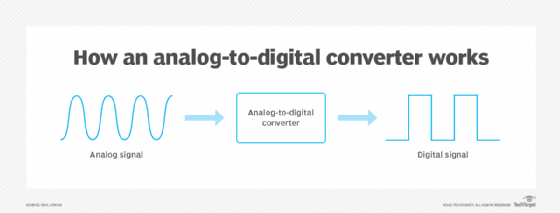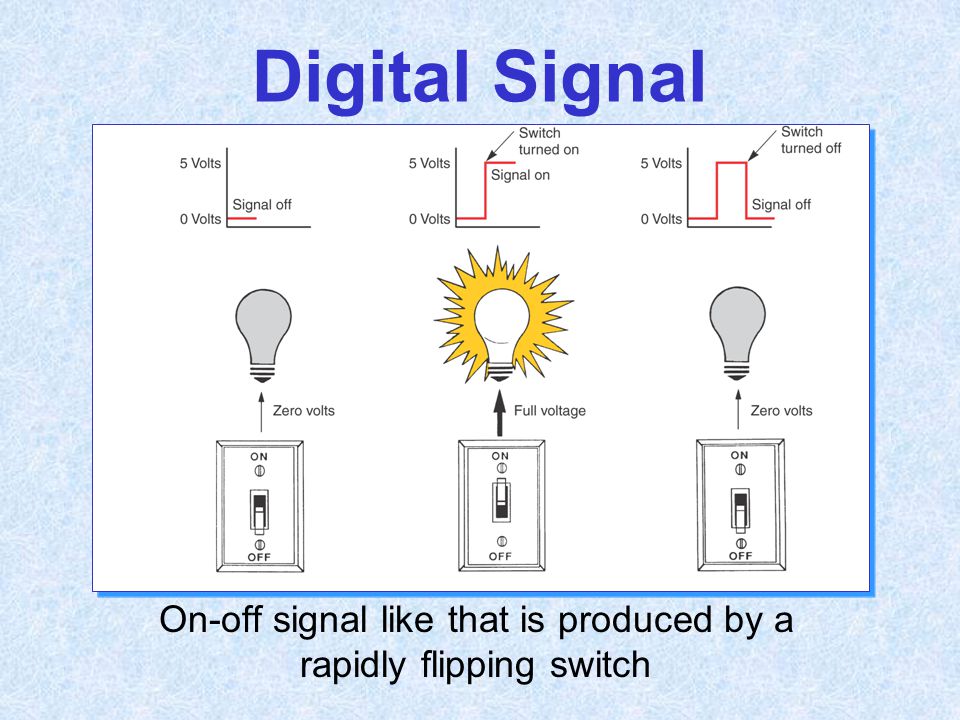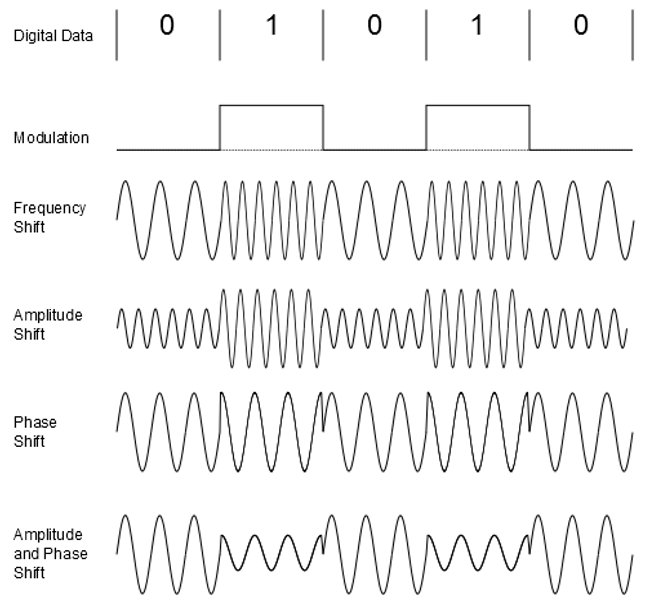Digital Signal
Subject: Science

Overview
Digital signals must be converted back to analog signals to be visible and audible. The information and communication fields are increasingly using digital signals due to their simplicity. The term "Digital Native" has been created to promote positive online behavior. Signal transmission involves transforming a signal and sending it through a medium, such as sound or electromagnetic waves. Baseband transmission transfers digital signals without converting them into analog signals, used for short distances. Broadband transmission uses digital signals to transmit data over multiple devices, with advantages such as low degradation, reliability, affordability, and security. Encoding and compression maintain information security and reduce errors.
Internet TV and Dish TV have since taken the place of the antenna-powered television in the figure. Cable TV was quite popular prior to the development of Dish TV. The TV with an antenna has the lowest audio-visual quality out of the three models we previously reviewed. The waves in this type of transmission go through the atmosphere, losing energy as they go through the environment and eventually reach the user's home. Consequently, they result in reduced P.D. on the antenna and a drop in the electrical current passing through the wire that is connected to the antenna. The same current is used in the modulated signal for television transmission.
The television's internal circuits transform the signal passing through the cables into digital signals, which are then used to broadcast audio-visual content. The signals that are transmitted across the wire in cable TV are also modulated signals. A cable modem is required if a computer is to be used as a television by connecting a cable from the computer. In contrast, Dish TV transmits digital signals that it receives from the satellite.
To produce signals that are visible to the eye and audible to the ear in such broadcasts, digital signals must be transformed back to analog signals. Consequently, a device that translates analog signals into digital signals and back again into analog signals is required for signal transmission.
The information and communication fields have begun to employ digital signals increasingly frequently due to their simplicity of transmission. In light of this and people's shifting social media behavior, the term "Digital Native" (also known as "Digital Citizen") has been created. Being kind and taking part in other positive activities when conversing online improves people's online reputations. While using internet resources improperly can have negative effects on our mental, emotional, and physical well-being, they can also have numerous positive effects.
Digital signal
Observation of Digital Signal Graph
Create an electric circuit by joining a source of 5 V alternating current, a lightbulb, a switch, and a conducting wire. When the switch is turned on and there is a 5 V potential difference between the two ends of the bulb, this voltage is regarded as a strong signal (1). The potential difference between the two ends of the bulb becomes zero when the switch is turned off. This signal is regarded as low (0). As time goes on, observe the high and low signals that the circuit generates. Write them down in a table and create graphs like the one in the figure.
A signal is a physical quantity that varies over time. By turning the switch on and off, digital signals are produced in the action. Electronic gadgets need a certain component, such as a transistor, to produce this kind of signal. In the exercise above, the voltage would have been higher if the switch had not been turned off and a graph of the potential difference at the two ends of the lightbulb against time had been created. seen steadily rising and falling. This transmission is analog.
A digital signal with just two digits (0, 1) is what the binary system uses. The combination of these two binary digits represents digital signals. For instance, as Table 1 illustrates, a binary number consists of just two digits: 0 or 1. Two binary digits can be combined in four different ways. The three binary digits can be combined in eight different ways.
| Table 1 | Table 2 | ||||
| Number of binary digits | Possible combinations | Binary number | Switches | Binary number | Switches |
| 1 | 0 1 | 0000 | 0011 | ||
| 2 | 00 01 10 11 | 0001 | 0100 | ||
| 3 |
000 001 010 011 100 101 110 111 |
0010 | 1010 | ||
Digital signals that represent discrete data are shown in Table 2. This type of data is stored in the computer's memory. The needs of the user determine how much memory a computer has. It can hold a large amount of data forever. Users may easily save data in many different formats, such as text, images, music, and video.
Computer memory's storage capacity is expressed in terms of bits, bytes, gigabytes (GB), terabytes (TB), megabytes (MB), and kilobytes (KB). The table below illustrates the link between these units:
| 1 Bit (a binary digit) | Binary 0 or 1 | 1024 kilobytes | 1 Megabyte (MB) |
| 4 Bits | 1 Nibble | 1024 MegaBytes | 1 gigabyte (GB) |
| 8 Bits or 2 nibbles | 1 Byte | 1024 CigaBytes | 1 TeraBytes (TB) |
| 1024 Bytes | 1 kilobyte (KB) |
Let us know
Bit: On a computer, a bit is the smallest type of data. It is a binary digit in abbreviated form, and its value can be either 0 or 1.
Byte: an eight-bit group that functions as a single data unit in a computer.
Difference Between the Digital Signal and the Analogue Signal
| Analog Signal | Digital Signals |
| The analog signal varies in time and is continuous. | Digital signals are binary signals with two or more states. |
| A sine wave is the typical shape of an analog signal. | A square wave is the typical shape of a digital signal. |
| Easily affected by the noise. | These are stable and less prone to noise. |
| Components like resistors, capacitors, inductors, and diodes are used in analog circuits. | Components like transistors, logic gates, and microcontrollers are used in digital circuits. |
Signal Transmission
We use sound as a channel for communication in our daily lives. The signal is analog. For instance, an analog communication signal is effectively sent across a wire on landline phones. Signal transmission may be defined as the process of transforming a signal and sending it through a channel or medium. In a similar vein, signals produced by potential differences, electromagnetic waves, etc. can likewise be used for communication. Analog signals are utilized for communication in the conventional mode of transmission.
As an illustration, consider a radio broadcast that transmits analog signals via medium waves and short waves. The sent signal in this sort of transmission may become ambiguous due to external factors such as atmospheric disturbances, wave mixing, etc. Similarly, it is also feasible to illegally record a phone call that is sent using analog signals. Various methods are used to digitalize analog signals in order to prevent signal distortion and for signal protection. Without affecting the data, digitalized signals improve the clarity and distinctness of the provided signals. A group of 0 and 1 can be used to store, transfer, and regenerate data in a digital system. There is extremely little chance of processing errors with this approach, making the data processing task easy.
Baseband Transmission and Broadband Transmission
Transmission of digital signals over channels without first converting them into analog signals is referred to as baseband transmission. Sending and receiving signals happen simultaneously in the same channel during this transmission. It is used for transmission across short distances. Baseband transmission, for instance, is the process of transferring data over a wire from one computer to another.

Broadband internet is commonly considered high-speed internet in our language. The broadband transmission of data over several devices is known as broadband internet. Transmitting digital signals to a channel after converting them to analog signals is known as broadband transmission. It is necessary to modulate this kind of communication. Analog signals can be sent via broadband transmission at different transmission frequencies as optical or electromagnetic waves. The transmission medium, or channel, is split into two distinct channels in order to send and receive signals. Two different cables can be utilized for broadband transmission as an alternative to this. Long-distance transmission is accomplished with this kind of transmission.
Advantages of Digital Transmission
- There is extremely little degradation or noise in digital signals.
- Digital transmission circuits are far more dependable.
- Compared to analog circuits, digital circuit design is more affordable and simpler.
- With digital transmission, there is a reduced chance of crosstalk and signal overlap.
- Under typical circumstances, the characteristics of digital signals remain constant.
- By using encoding and compression, information security in digital transmission can be preserved.
- There is less possibility of an error occurring during transmission because codes are utilized to identify and fix errors.
Things to remember
- Internet TV and Dish TV have replaced antenna-powered televisions, which have lower audio-visual quality. Cable TV uses modulated signals, which are transmitted through wires and require a cable modem. Dish TV uses digital signals from satellites.
- Digital signals are binary signals with two or more states, with the typical shape of a sine wave and are less prone to noise.
- Analog circuits use components like resistors, capacitors, inductors, and diodes, while digital circuits use components like transistors, logic gates, and microcontrollers.
- Analog signals can become ambiguous due to external factors, but digitalization improves clarity and distinctness.
© 2021 Saralmind. All Rights Reserved.







 Login with google
Login with google